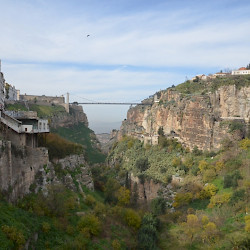Jona Lendering
Jona Lendering read history at Leiden University (MA 1993), specialized in Mediterranean culture at the Amsterdam Free University (MA 1996), and worked at excavations in Holland (Riethoven) and Greece (Halos). After teaching historical theory and ancient history at the Free University for several years, he was one of the founders of a school for history teaching, Livius Onderwijs. Born in Amsterdam, it has now spread to auxiliary locations in Bussum, Dronten, Gouda, Haarlem, Hoorn, Schagen, Zaanstad, and Zoetermeer. As of 2013, Livius Onderwijs has eight teachers, about 500-600 students a year, and offers tours to countries like Italy, Turkey, Iran, and Lebanon. The field trips help to etch into the students' minds some of what they've learned at the school.
Because history is for a large part telling a story, something you do best in your own language, Lendering prefers to publish in Dutch journals. However, he has contributed to the Bryn Mawr Classical Review and Ancient Warfare, while he is the founder of Ancient History Magazine. He is also the publisher and editor of the on-line publication of the Babylonian Chronicles of the Hellenistic Period, a set of important cuneiform sources for the history of the Seleucid and Parthian Near East, transcribed, translated and commented on by Bert van der Spek of the Free University Amsterdam and Irving Finkel of the British Museum. A publication as book is in preparation.
Lendering has written several books and maintains a blog in Dutch. He is the author of several books, including Edge of Empire and Consensus and Crises. For the Livius website, which has received several awards, he collaborates closely with Bill Thayer of LacusCurtius. Lendering is also the webmaster of two daily blogs, the MainzerBeobachter.com and Grondslagen.net.
There are 9380 items in Jona Lendering:
Conon
CononConsilium principis
Consilium principisConstans
Constans: emperor of the Roman world (r. 337-350). Constans Names: 320 or 323: Flavius Constans 25 December 333: Flavius Constans Caesar 9 September 337: Flavius…Constanța, National History and Archeology Museum
Archaeological museum There are 1 items in Constanța, National History and Archeology Museum: …Constantine II
Constantine II: emperor of the Roman world (r. 337-340). Constantine II Names: 7 Augustus 316: Flavius Claudius Constantinus 1 March 317: declared caesar 9 September…Constantine the Great
Constantine I the Great: emperor of the Roman world (r. 306-337). Constantine the Great Names: 27 February c.273: Gaius Flavius Valerius Constantinus 25 July…Constantine, Musée Cirta
Nice archaeological museum with Prehistoric, Numidian, and Roman finds. This museum has a fine numismatic collection, a great number of steles from the Hofra sanctuary near Cirta, and finds from the mausoleum at Soumaa d'El Khroub. …

Constantine, Pont de Sidi M'Cid |
Constantine's City
Constantinople (Κωνσταντινούπολις) or Byzantium (Βυζάντιον): Greek city on the Bosphorus, capital of the Byzantine Empire, modern İstanbul. Constantine the Great At the…Constantinian Dynasty
Constantinian Dynasty: the family of the emperor Constantine the Great, which ruled (parts of) the Roman Empire from 305 until 363 CE. …Constantinople - photos
Constantinople (Κωνσταντινούπολις) or Byzantium (Βυζάντιον): Greek city on the Bosphorus, capital of the Byzantine Empire, modern İstanbul. Imperial eagle, on a…Greek Byzantium
Constantinople (Κωνσταντινούπολις) or Byzantium (Βυζάντιον): Greek city on the Bosphorus, capital of the Byzantine Empire, modern İstanbul. The acropolis of Byzantium According…